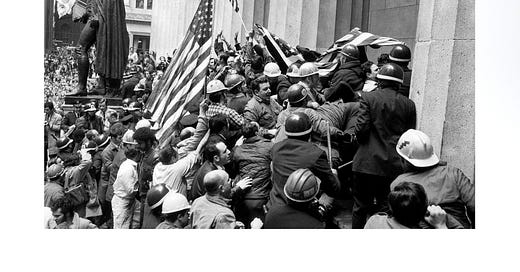The culture wars now ripping through American politics — especially noticeable in these last few weeks before the midterm elections, when Trump is trying to lay the groundwork for an authoritarian takeover — arguably began on May 8, 1970 in New York City.
That day happened to be the 25th anniversary of the Allied victory over Germany in World War II. It was also weeks after Richard Nixon expanded the Vietnam War into Cambodia. And it was just four days after Ohio National Guardsmen shot dead four students during antiwar protests at Kent State University.
I recall it vividly.
On May 8, 1970, a riot broke out in New York City.
Around noon, near the intersection of Wall Street and Broad Street in Lower Manhattan, more than 400 construction workers — steamfitters, ironworkers, plumbers, and other laborers from nearby construction sites like the emerging World Trade Center — attacked around 1,000 student demonstrators (including two of my friends) protesting the Vietnam War and the May 4 Kent State shootings.
The workers carried U.S. flags and chanted “USA, All the way” and “America, love it or leave it.” They chased the students through the streets — attacking those who looked like hippies with hard hats and weapons, including tools and steel-toe boots.
I heard about it when several friends from New York who were active in the anti-Vietnam War movement phoned me later that day. To characterize them as upset understates their emotions.
As David Paul Kuhn reports in The Hardhat Riot, the police did little to stop the mayhem. Some even egged on the thuggery. When a group of hardhats moved menacingly toward a Wall Street plaza, a patrolman shouted: “Give ’em hell, boys. Give ’em one for me!”
The workers then stormed a barely-protected City Hall where the mayor’s staff, to the hardhats’ rage, had lowered the flag in honor of the Kent State dead. They pushed their way to the top of the steps and attempted to gain entrance, chanting “Hey, hey, whatcha say? We support the USA!”
Fearing the mob would break in, a person from the mayor’s staff raised the flag.
It was a small precursor to the attack on the U.S. Capitol more than a half-century later.
The workers ripped down the Red Cross flag that was hanging at nearby Trinity Church because they associated the flag with the anti-war protests. They stormed the newly built main Pace University building, smashing lobby windows and beating students and professors with their tools.
More than 100 people were wounded. The typical victim was a 22-year-old white male college student, though one in four was female. Seven police officers were also hurt. Most of the injured required hospital treatment. Six people were arrested, but only one construction worker.
My friends escaped injury but they were traumatized. I remember them describing the rioting construction workers as a “pack of animals.”
The hardhat riot had immediate political consequences. Richard Nixon exploited it for political advantage. It was the first salvo in America’s culture wars.
Nixon’s chief of staff H.R. Haldeman wrote in his diary: “The college demonstrators have overplayed their hands, evidence is the blue-collar group rising up against them, and [the] president can mobilize them.”
Patrick Buchanan, then a Nixon aide, wrote in a memo to his boss, saying “blue-collar Americans” are “our people now.”
Peter Brennan, then president of the Building and Construction Trades Council of Greater New York, claimed “the unions had nothing to do with” it — although just before the riot, Brennan had held a rally of construction workers to show support for Nixon’s Vietnam policies.
Brennan explained that workers were “fed up” with violence and flag desecration by anti-war demonstrators.
At Nixon’s invitation, Brennan then led a delegation of 22 union leaders, representing more than 300,000 tradesmen, to the White House. They presented Nixon with several hard hats and a flag pin, after which Nixon praised the “labor leaders and people from Middle America who still have character and guts and a bit of patriotism”.
After the 1972 election, Nixon appointed Brennan labor secretary. Brennan did not distinguish himself in that position. He strongly opposed affirmative action. He also prevented Labor Department officials from investigating allegations of corruption in the Teamsters Union and of its president, Frank Fitzsimmons, who had helped secure labor support for Nixon’s election.
The hardhat riot revealed a deep split in America’s left — in the coalition of workers and progressives that Franklin D. Roosevelt had knitted together in the 1930s, and the wished-for alliance of Blacks, liberals and blue-collar whites in the aftermath of Lyndon Johnson’s landslide 1964 re-election.
The riot’s class-based and race-based tensions would worsen over the next half century, as America’s upper-middle class and wealthy began pulling away from white Americans without college degrees.
The construction workers who attacked the demonstrators on May 8, 1970, and the police who egged them on, were more likely to have family and friends in Vietnam than the college students who demonstrated. Many were veterans of World War II and Korea. They also lived in the same working-class neighborhoods.
They despised the protesters as a bunch of pampered, longhaired, draft-dodging, flag-desecrating snots.
They felt abandoned by the middle class and the college-educated, stiffed by the clever kids with draft deferments, forced to bus their kids to Black neighborhoods they didn’t trust and accept Black kids into their schools, and burdened by an economy no longer delivering the possibility of upward mobility.
As the journalist Pete Hamill observed at the time, the workingman “feels trapped and, even worse, in a society that purports to be democratic, ignored.”
The former Nixon aide Pat Buchanan, writing in 1988 about the future of the GOP, argued that it should have embraced these growing working-class resentments.
The Republican moment slipped by, I believe, when the GOP refused to take up the challenge from the left on its chosen battleground: the politics of class, culture, religion, and race.”
Three years later, Buchanan openly questioned whether democracy was the best form of government. “The American press is infatuated to the point of intoxication with democracy,” he wrote, comparing the Marine Corps and corporations like IBM to the federal government. “Only the last is run on democratic, not autocratic principles. Yet who would choose the last as the superior institution?”
Buchanan sought the Republican presidential nomination in 1992, 1996, and 2000. He lost, of course. But over the course of the 1990s, his ideas began taking root in the GOP.
When I was secretary of labor, I spent much of my time in the Midwest and elsewhere around the country where workers felt abandoned in an economy taken over by Wall Street. I witnessed their anger and resentment. I heard their frustrations.
The nation could have responded, but did not.












Share this post